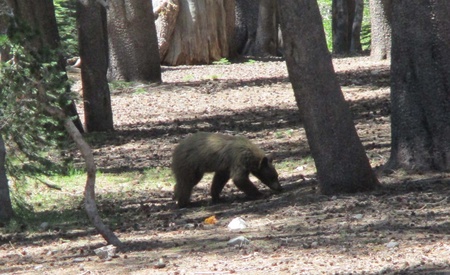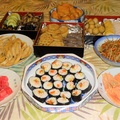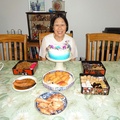My last fishing trip to the High Sierras was on Sunday, July 7, 2019. This was our annual family vacation away from our hectic life in the city. We would call ourselves the fishing four. My husband, John, started the fishing family tradition. He grew up fishing in Fresno. He never forgot the joy of fishing with his dad. Once his sons, James and David, were old enough to hold a fishing pole, he taught them how to fish the High Sierras. Now, it has become a Japanese tradition in our family. James and David were automatic members of the fishing four while I became an honorary one.
John, James, and David were masters in planning the 5-hour drive from Los Angeles to June lake and making it into a fun road trip. We packed our clothes, fishing tackle, ice chests, water, snacks, sunglasses, hats, insect spray, and sunscreen into our van. We were ready to go.
James drove first from Los Angeles to Mojave. We made our annual stop to McDonald’s for breakfast. John and I shared a Big Breakfast with two coffees. James and David had their breakfast meals with hash browns and drinks. When we left, the temperature outside was in the 90’s by 11:00 am.
David would drive us from Mojave through the towns of Lone Pine, Independence, Big Pine, and ending up in Bishop. Our favorite stops in Bishop were Erick Schat’s Bakery and Mahogany Smoked Meats. At Schat’s Bakery, we bought Russian Raisin bread, coffee cake, and a variety of cookies including chocolate chip, Swiss pecan, and shortbread. At Mahogany Meats, we bought 4 take-out sandwiches with potato salads for our first dinner at the cabin in June Lake. I also bought 3 packs of smoked bacon to take home and 2 packages of garlic pistachios for snacks. We gassed up our van and were on the road again.
John drove last from Bishop to Mammoth Lake. Our stop in Mammoth was for groceries at Vons. We bought and filled 6 shopping bags with food for breakfast, lunch, and also dinner if we did not catch enough trout. We rewarded ourselves with Starbucks drinks. Then John drove straight to June Lake and arrived at our final destination, cabin #6. This was our favorite cabin to spend 3 days of fishing. We were very excited!
We unpacked our groceries, clothes, and snacks from Schat’s Bakery and Mahogany Meats. We were tired and hungry from the long drive. We had a late dinner with our sandwiches and potato salads from Mahogany. John and I ate our Classic Turkey sandwich, David, his California Cuban made of ham and chicken and James, his Rodeo sandwich which had roast beef, smoked bacon, and pepper Jack cheese. After our dinner the men set up the fishing poles while I made both onigiri (rice balls) and sandwiches which I packed with potato chips, cookies, fruits, and water for tomorrow’s bento (lunch). We went to sleep early that night.
On Monday, July 8, we ate a light breakfast of cereal with milk or bagels with cream cheese and hot coffee. Our first fishing spot in June Lake was Grant Lake. We saw ducks swimming in the lake and the seagulls flying overhead. The water level was high at the lake and the trout hid in the rocky reefs. We had to throw our fishing lines further out but our lines always got caught on the rocks. Our patience ran out when the mosquitos were biting our skins and the hot sun was beaming down upon us. There were no trees around the lake. We were busy applying sunscreen lotion or spraying ourselves with insect repellent. However, James and John were able to catch one trout each. David and I caught none, not even a nibble.
Our second fishing spot was Rush Creek which was a deep fast running stream with overgrown bushes and heavy terrain. We carried our fishing tackle down to the stream. We were fighting the rushing water, the heavy winds, and the tall weeds which hid the trout. No wonder, we did not hook any trout.
We returned to the cabin, ate our lunch and cleaned the two trout. We froze the trout inside zip lock bags with a small amount of water and stored them in the freezer. In lieu of trout dinner, we ate our store bought, roasted chicken, steamed rice, potato salad, macaroni salad and cold drinks. Our dessert was ice cream with fruits. Afterwards, I would make bento again. We would talk about our first dry spell in fishing, and played our two favorite games, Hanafuda (Flower card game) and Crazy 8 until bedtime. For the next two nights, we would repeat this family fishing ritual of cleaning the trout, eating dinner, making bento, talking about fishing and playing games together.
On Tuesday, July 9, we drove 30 minutes to Mammoth Lakes. Our two favorite fishing holes in the Mammoth area are Lake Mary and Lake George. Lake Mary is a smaller lake with boulders and small hills. We carried our snacks, water, and fishing gear up the hill. We saw people fishing on the banks or in their boats. It was cooler that day because of the trees along the lake. This time the ants were biting. When we threw our lines into the lake, John hooked a big trout. The big trout swam fast between the rocks and the fallen trees. John’s fishing line got tangled onto one of its branches and his line broke. The big one got away. David and I caught one trout each, placed them onto a stringer and dropped them into the lake.
We started snacking on some cookies and chips when we heard voices yelling “A bear is coming!” John picked up the stringer with the two trout and ran up the hill. James, David, and I followed safely behind him. Suddenly, we saw the small black bear roaming around looking for food. He smelled our snacks, sat down, and ate it. The bear ran away when he heard a dog barking.
We decided to drive up to Lake George. We did not take any more chances and ate our lunch in the van. Lake George was a bigger lake enclosed by mountains and surrounded by big boulders and tall trees. The lake was so picturesque with a big waterfall running down the mountain into the deep blue water below. The weather was cold and windy because it was late in the day. We saw small chipmunks and tiny birds searching for food. James and David were able to hook two trout. I caught 1 and John had no luck. He caught none. We did release some smaller ones. Fishing was slow again. We called it a day, packed up, and drove to downtown Mammoth.
We shopped at the Mammoth Antique Thrift store and bought our dinners at a café named Delicious Kitchen. We survived our day with the bear by ordering Starbuck’s drinks. We continued our family fishing ritual, talked about John’s big trout that got away and played our games. Soon it was time to go to sleep. Tomorrow was our last day of fishing.
On Wednesday, July 10, we returned to Grant Lake and fished half a day. David and I caught one trout each. We all agreed to eat our lunch in the cabin since it was so hot and the mosquitos were biting again. We cleaned the fish and tallied our catch. John caught 1, James 3, David 4, and I caught 3 trout. The total catch was 11 trout. Rather than worrying about our small catch, we talked about how much fun we had together. We still considered ourselves the fishing four. We ate what was left for dinner, played games, washed our dirty clothes, and started packing for tomorrow. This was our last night.
On Thursday, July 11, we ate breakfast early, cleaned the cabin, and threw out the trash. We packed the rest of our clothes, our fishing gear, and our ice chest filled with our 11 frozen trout into the van. We were set to go. We would take turns driving home, stopping at our favorite places, and talking about our best parts of fishing. James and David found enjoyment in Mother Nature. They would remember the beauty of the waterfall at Lake George, the fast-moving stream of Rush Creek, the black bear at Lake Mary, and the ducks swimming at Grant Lake. John found a deep appreciation for the quietness and the patience of fishing. I found the calmness and the peacefulness in the High Sierras.
We learned to build a stronger family bond together and to create ever lasting memories. The fishing four will forever be our Japanese tradition. Our sons will make their own fishing families after we are gone but they would never forget their last trip. Our drive home was the best of all.
© 2020 Mary Sunada








